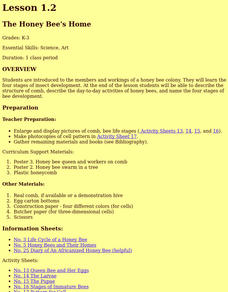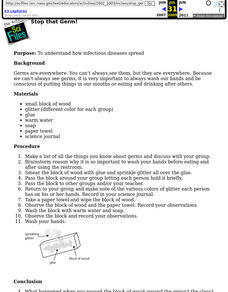Curated OER
Living or Nonliving
Learners explore the characteristics that distinguish living things from nonliving things. By examining video and photographs, students gather evidence and develop criteria to decide if something is living or nonliving.
Curated OER
The Honey Bee Body - Paper Honey Bee
Students construct a paper honey bee to learn the six major parts of a bee and other insects. They compare their own body parts to those of bees. They utilize worksheets imbedded in this plan to help them design their bee.
Curated OER
The Honey Bee's Home
Learners are introduced to the members and workings of a honey bee colony. They describe the structure of a comb, the day-to-day activities of honey bees, and name the four stages of bee development. They construct a honeycomb model.
Curated OER
What's In The Forest?
Students examine forest food chains and create a forest habitat in the classroom. They are introduced to the concept of interdependence in Nature. They define a simple forest food chain and develop inquiry process skills.
Curated OER
The Mystery Seed
Second graders create a short descriptive story describing a mystery seed they have planted. They incorporate needs that must be met in their story for a seed to grow. They create an original picture using the Kid Pix software program.
Curated OER
Under The Sea - Describing an Ocean Picture
Second graders create original complete sentences to describe an ocean picture under the sea. After a lecture/demo, 2nd graders use a software program to create their own undersea scene, complete with pictures and writing.
Curated OER
Life Cycle Of A Frog
Students use books and an art activity to study the stages of a frog's life cycle. After listening to a book about frogs, students engage in a fun art activity. When finished, students work is displayed as a pond on the bulletin board.
Curated OER
Who's Coming to Lunch: A Study of Mold Growth
Students participate in an experiment to determine where fungi and molds are formed, and create graphs documenting fungal growth.
Curated OER
Stop that Germ!
Students experiment with glitter to explain the importance of washing hands and how germs are distributed. After a lecture/demo, students perfom a simple experiment which clearly demonstrates how germs are spread.
Curated OER
Life Cycle of a Frog
Students work together to explain and illustrate the life cycle of a frog.
Curated OER
Taste (Gustation)
Students conduct various experiments to see if different parts of the tongue are more sensitive to different characteristics of food.
Curated OER
Travel to the Polar Lands
Second graders receive an "Expedition Ticket" to travel through the Polar Regions- the Arctic and the Antarctic. They research polar bears and make drawings that are to scale.
Curated OER
Where Plants and Animals Live
Learners explore and discuss facts about a woodland environment, the plants and animals that live there, and changing seasons in the woods. They conclude that plants in the woods provide food and shelter for animals living there.
Curated OER
How Does Whale Blubber Work?
Students perform an experiment to find out how whale blubber keeps whales warm in cold temperatures. They use Ziploc bags lathered in shortening to simulate whale blubber. They put their hands in cold water, both with and without the bags.
Curated OER
Animals and their Habitats
This animal habitat PowerPoint provides beautiful photographs of a rainforest, desert, and grassland habitat, as well as animals native to a rainforest and the desert. The first slide lists rainforest, desert, tundra, and grassland as...
Curated OER
My Farm Animal Needs
In this farm animals worksheet, students write or draw the necessary things their chosen farm animal needs. There are no directions on the page.
Curated OER
What Cats Need
In this pet care instructional activity, learners analyze a photograph that shows the necessary items needed for cat care. There are no directions on the page.
Curated OER
It's Alive! Or is it?
Students differentiate the characteristics of living and nonliving things. In this life science lesson plan, students compare and contrast robots and living things. Given an object, they decide whether it's is living or not and defend...
Curated OER
Shapebook: "Look What We Found!"
In this newt worksheet, students complete 5 fill in the blank questions regarding animal characteristics of a newt. Students complete answers inside a fishbowl shape worksheet.
Curated OER
Making a Model Lung
Students build a model lung. In this life science instructional activity, students name the different parts of the lung and their function. They explain the process of breathing.
Curated OER
Bean Bugs
Learners practice how to estimate the size of a population of organisms. For this estimation lesson, students hypothesize how to estimate a population of organisms. Learners learn to use a quadrat system to estimate population.
Curated OER
Obis Oil Spill
Students explore environmental challenges by participating in an oil spill simulation. In this water safety lesson, students discuss why oil spills happen and how their impact affects the entire ecosystem. Students utilize popcorn,...
Curated OER
Snug as a Bug
Learners investigate survival strategies. In this survival strategies lesson, students study survival strategies used by animals. Using a seed to represent a bug, learners create a safe home for their "seed-bug".
Curated OER
Water Striders
Students analyze water strider behavior. In this water strider lesson, students study the movement and feeding behavior of water striders. Students catch water striders and then generate scientific observations.

























